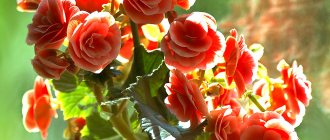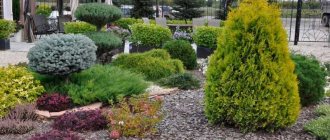Features, goals and objectives
Loaches are the general name for plant species that, during growth, spread, climb and cling to any vertical support. For the former, it is imperative to build a frame and create conditions under which they will be able to rise upward. If this is not done, they will cover the ground with a beautiful flowering carpet.
Without a vertical frame, the loaches will completely cover the ground with a continuous carpet Source s1.1zoom.me
Climbing loaches are able to cling on their own and crawl towards the sun. Any vertical wall is enough for them, the main thing is that its surface is slightly rough (brick, concrete). Such plants are ideal for cladding a residential building.
A brick wall is an ideal basis for climbing plants Source avatars.mds.yandex.net
Clinging plants rise upward thanks to their tendrils. With them they grasp the support and securely fasten to it, allowing the stem to actively develop and again produce shoots for adhesion. Such vines require a frame in the form of a mesh or a stretched rope.
For clinging loaches, a net is needed as a support Source i.pinimg.com
Supporting vines require one vertical support, so they are ideal for decorating an arch or pergola. Half-lianas need to be fixed, fastenings created for them and thereby form the desired form of landscaping.
Branched roses are half-lianas; they need one support to mount them Source yandex.net
Loaches are a group of flowering plants that can give any area a picturesque appearance. Due to their growth, they help create a three-dimensional vertical green space; with their help it is easy to form the required volume. Landscape designers love to use vines to create diverse stylistic zones, romantic corners that can charm anyone with their freshness and rich colors.
Beautiful green arch over the pond Source yandex.net
Usually beautiful climbing flowers are unpretentious in care, they are resistant to cold, and do not require much space to grow them. In order to completely cover the wall of a house with greenery, it is enough to plant a plot of land forty centimeters wide with vines. Perennial vines can be cultivated for several years.
Loaches are a godsend for the designer. Using them, it is easy to decorate open arches, create green grottoes, and build gazebos from plants. When the vines grow and become like a fluffy blanket, it becomes an excellent protection from wind and rain; the denser the planting, the less noise the structure allows through. It will be nice to climb inside with a book and, hiding from the sun, read your favorite author.
Bench inside the green grotto Source www.thestar.com
Densely planted vines can hide flaws in the frame of an open gazebo. If it is not possible to repair it or the pergola, plant flowering vines around its perimeter. They can also cover unsightly outbuildings, camouflage sheds, workshops, landfills, and compost heaps.
An unsightly façade of a utility block covered with a green liana Source 98.r.photoshare.ru
See also: Catalog of projects of houses with a garage for permanent residence in the chalet style.
Plantings of this kind attract birds. They love to build nests in them. This is very useful for the garden: birds repel most pests, they are their main food. Various flowering perennials are used in landscape design. But the following plants are the most popular.
Azarina
It is a fast-growing vine that gains leaf mass in a very short time. It grows in different directions, stretches not only upward, but also in width, which is very convenient when landscaping large areas of steep surfaces. It can be used to cover a layer of earth. After two weeks of planting in the ground, the shoot of the bush will completely cover one square meter of soil.
Fast-growing climbing azarina Source ogorodnash.ru
During the growing season, the stem grows up to five meters. It is densely covered with heart-shaped foliage. During the flowering period, pink, purple or blue buds appear. As they bloom, they become bell-like. At this time, the bush looks very picturesque.
Aconite
It belongs to the ranunculaceae family of perennial flowers. The plant is unpretentious, grows on any poor soil, does not require any care, and during the peak of the warm season it grows up to two meters. Then blue buds with a purple tint appear on it. Blooming, they take the form of a combat helmet, from which a high cap protrudes.
Aconite is the second name for “fighter”: the shape of the flowers is similar to the helmet of Roman legionnaires Source yandex.net
A couple of dozen of these atypical flowers are collected into one large brush. It is placed at the top of the shoot. In late autumn, the perennial dies, its root remains in the ground, it is small, short, slightly swollen, covered with black hard bark. This shell helps to withstand frost well. The sap of the plant is poisonous. In the ancient legends of the Scandinavian peoples there are recipes for preparing a potion from it for priming arrows. For this feature, the loach received a second name. Amateur gardeners call it a “fighter” among themselves.
The aconite brush is very beautiful Source etosibir.ru
See also: Catalog of companies that specialize in landscape design, small forms and winter gardens.
Clematis
If you need an ornamental garden loach that can successfully compete with overseas exotic flowers in its beauty, you should plant clematis. They grow very quickly, the stems stretch to a height of up to two meters, conquer their limit, and then collapse onto the garden with a green waterfall, completely covered with beautiful bright two-color flowers.
Waterfall of bright colors Source yandex.net
The plant feels comfortable in fertile soils; it needs good lighting and reliable protection from the wind. Growing it is not difficult, but clematis will still make the owner of the garden sweat a little, but then they will give him luxurious flowering that will last a couple of weeks.
Wisteria
A luxurious loach with lacy leaves and long (up to half a meter) tassels of flowers of light purple, pink, and blue, emitting a subtle sweet aroma. Such climbing ornamental plants for the garden are chosen when you need to create a special effect of luxurious decoration. The Japanese (the most reserved people in expressing emotions) compare walking along alleys decorated with wisteria to walking in paradise.
An alley decorated with blooming wisteria Source ic.pics.livejournal.com
Occupying a minimum area, the plant helps create exceptional decorativeness. It easily climbs up the supports, covers the entire wall and well masks all unsightly areas.
Wisteria is an exclusively ornamental plant Source content-4.foto.my.mail.ru
There are many options for using wisteria in landscape design. It can be used to decorate alleys, cover pergolas, open terraces, and fences.
Landing technology
Planting technology differs little from the procedure for ordinary plants. For propagation, in most cases, seeds or pre-prepared seedlings are used. Let's take a closer look at the landing procedure.
Growing bindweed from seeds
Decorative bindweed is often used in various landscape designs. The wall made from it is quite dense, uniform, and aesthetically pleasing.
For propagation, the seed method is used, but with preliminary harvesting of seedlings: At the end of March - early April, you can begin harvesting seedlings. But before planting the seeds in cups, they must be kept in water for a day.
Fill the cups with nutritious soil, consisting of high-quality soil and peat in a ratio of two to one (two parts of soil account for one part of fertilizer).
Make a small hole in the containers - excess liquid will drain out through it. The jars are stored in a warm room and watered as the soil dries. The first shoots can be observed after 10-14 days.
Planting bindweed in the garden
The soil must be prepared in advance, dug up and fertilized, and peat added. Before planting, it is better to water the plant abundantly - this way it will easily slip out of the jar without being damaged. The sprouts are planted in small holes located at a distance of 20-30 centimeters from each other.
Planting ends with watering the plant: this way it will take root faster and develop a root system. In the early stages, it is important to monitor the condition of the stems and leaves.
The presence of plaque, lethargy, change in color - all this may indicate the development of diseases or pests. It is important to spray on time and add additional fertilizer to the soil.
What time to plant
You can plant bindweed starting in mid-May, when the weather settles, becomes warm, and night frosts disappear. But the weather varies from year to year, so you should focus on current conditions.
Bindweed grass is a heat-loving plant, so it is better to choose a place on the sunny side, then the colorful buds will delight the eye for a long time and decorate the garden area or local area.
Caring for bindweed
Care includes several basic rules:
- Regular and sufficient watering. Lack of moisture, as well as excess moisture, can cause the development of diseases of the root system.
- Weeding. Needed only after planting: a strong, mature plant is not afraid of weeds.
- Installing supports as you grow. The shoots need to be directed to the right sides in a timely manner; this is the only way to get an even, beautiful green carpet.
- Partial cutting. An optional maintenance factor, but permitted if landscape design requires it.
If field or garden bindweed grows slowly, you can add a little food for flowering plants to the soil or sprinkle the roots with ash.
Rules for creating vertical gardening
Loaches are not suitable for decorating flower beds: in a short time they fill the entire space, and the module loses its shape. This makes its decorativeness disappear. Creeping, climbing, clinging plants are used to enliven fences, house facades, and gazebos. Dense planting of such specimens along the perimeter of the fence can save you from street noise and gases coming from a busy road. Whatever style of landscape design is chosen, their presence will be appropriate everywhere.
Fences tightly covered with vines Source yandex.net
In order for the plant to demonstrate all its beauty, it is important to choose the right support for it. It is necessary to remember that perennial vines do not tolerate movement well, so you will have to decide in advance how to beautifully plant the vines, how to arrange them along the vertical axis, taking into account climatic conditions and the requirements of modern agricultural technology.
Climbing plants need proper support Source dachadesign.ru
Observations of traditional healers
Traditional healers often use bindweed to prepare various medicinal mixtures. This tradition came from the medieval Arab physician Avicenna.
In his treatises, he described in detail the procedure for using this plant for certain diseases. He claimed that the flower helps cleanse blood vessels, improve blood quality, and strengthen the stomach.
Avicenna used bindweed and its juice to treat jaundice, and a mixture of seeds to relieve fever. He also gave examples of use for cancer, but this fact has not been confirmed in modern folk medicine.
Bindweed, for its medicinal properties, has been used by healers in many countries, including India, Central Asia, Tibet and Russia.
Briefly about the main thing
Loaches are ideal for vertical gardening; with the help of planting such plants, you can zone a site, decorate the facades of houses, mask their defects, and completely cover fences and outbuildings with a green blanket.
There are a large number of decorative species, including creeping and creeping vines. In order for everyone to reveal their beauty, it is necessary to choose the right support for it.
The rules for creating vertical gardening are extremely simple; it is important to take into account the frost resistance of loaches, its compliance with existing climatic conditions, and the growth pattern of the vine.
Gardeners necessarily include azarina, aconite, clematis, wisteria, virgin grapes and perennial morning glory in the list of the most popular loaches.
Ratings 0











